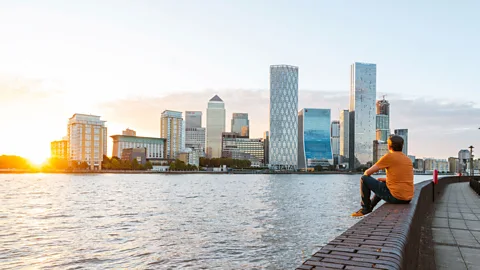 Getty Images
Getty Images
As businesses downsize in the hybrid-work era, empty offices could become 'flats for millionaires with little daylight' – or an opportunity to reinvent the city centre.
As more employees work from home in the hybrid-work era, many companies are finding they need smaller offices. Compared to pre-pandemic floorplans designed to house as many workers as possible, more businesses are looking towards more compact but higher-quality spaces for the future.
According to figures from global commercial real estate firm JLL, 48% of clients in major markets, including the UK, Germany and France are seeking to decrease their footprints in the next three to five years as a result. "Our clients are working out what to do with the space they've got by analysing data from recent years to come up with long-term plans," says Stephanie Hyde, CEO UK and CEO EMEA Markets at JLL. "In addition, many leases are expiring, companies are pressing ahead to meet sustainability agendas and they're focusing on getting hybrid working right."
This imminent corporate downsizing is set to have huge ramifications for the real estate industry. As more leases end, experts anticipate a tidal wave of available commercial space on the market. According to March 2024 data from workplace research firm Leesman, total space reductions could reach 40% across its global client base of 766 firms. Projected onto central London, if the same proportion of the city's occupiers opt to reduce their footprints, this corporate downsize would be the equivalent to 56.6 million sq ft (5.26 million sq m) of office space.
In the rush for better workplaces, the offices left behind may remain empty. "More organisations are looking for spaces that enable a better workday for employees, in more attractive parts of the city," says Tim Oldman, founder and CEO of Leesman, based in London. "As companies pay top dollar for quality, the gravitational pull to newer, higher-quality offices leaves behind a vacuum for lower-grade buildings."

 Getty Images
Getty Images
Not all vacant buildings can be updated to meet new market demands, nor retrofitted into residential units. "Many large organisations are chasing net zero targets, so will move to newer buildings with environmental certification and the latest technology," says Oldman. "And the investment behind commercial real estate – designed for mass open-plan spaces – means it's not economically or practically viable to repurpose them into homes. They'd be flats for millionaires, with little daylight."
Businesses are also being more selective over where to base their headquarters, says Duncan Swinhoe, managing principal for Europe at design and architecture firm Gensler, in London. A traditional tenant in the city's central Mayfair district, such as a hedge fund, may now be more inclined to relocate to "edgier" neighbourhoods that appeal to more employees, he adds. "The proximity to amenities, coffee shops, bars and good transport links is a much more significant factor in location now – employers want to attract their people to the office."
While a market reset may be on its way, Oldman says he doesn't believe the commercial real-estate industry, nor entire business districts, will be wiped out in the long term. "As more companies opt for newer offices that look stunning, in great locations and with fantastic space inside, there will be a raft of older buildings plummeting in value. But there are too many people with huge sums of money invested to allow a cataclysmic event to happen, and for swathes of cities to become ghost towns."
We could see these parts of cities become pockets of creativity, filled with community-centred businesses, specialist services and experiential spaces in a more shared environment – Tim Oldman
Instead, over the following decade, vacated commercial buildings are set to be updated, transforming areas formerly packed with office workers during workweeks, and nearly deserted over weekends, into "hybrid destinations" filled with greater green spaces, pedestrianised areas and leisure options that keep a more consistent weekly footfall.
Purpose-built business districts will need updating, says Swinhoe. He cites London's largest financial district, Canary Wharf as an example. "It has very large single-use buildings, designed in a monofunctional area, that now needs reinventing to support a wider range of uses."
More like this:
Mixed-use neighbourhoods are already common practice in North America, says Swinhoe, where developers are typically less constrained by the centuries-old urban planning and heritage protection of European cities. For example, developments like New York's Hudson Yards combine office, residential and retail space without one dominant form of real estate. But such spaces have been emerging in London as well, notably Coal Drops Yard in King's Cross, which mixes entertainment venues with low-rise retail and high-rise offices.
Oldman believes these creative developments could be the blueprint for regenerating districts struck by empty offices. "'Mixed use' once meant areas laden with offices, some residential space and a smattering of retail," he says. "Now, we could see these parts of cities become pockets of creativity, filled with community-centred businesses, specialist services and experiential spaces in a more shared environment."

 Getty Images
Getty Images
The result is that city centres are set to be recalibrated. "Twenty years ago, the heart of the master plan would be the central business district, with the financial district at its core, and everything else revolving around it," says Swinhoe. "That's now changing so that the city's beating heart is centred on lifestyle, entertainment and amenities, rather than merely business – it's reconnecting cities as places where people come together to build lives, not just work."
More immediately, cities may face an office exodus. Some cities are teetering closer to the edge than others. Much of this is determined by lease length: for example, while Oldman says the average London lease length is 12 years, some major business hubs have only five years, such as Zürich. Some city centres are already experiencing the phenomenon: since the pandemic, Manhattan lease lengths have slumped below 10 years, and iconic buildings such as the Flatiron have remained vacant as companies downsize.
A deadline is looming though, and a mass influx of commercial real estate is on its way. "In most large cities, there is going to be an oversupply of average and bad spaces," says Oldman. "Developers might be forced to the cliff edge to be creative, but they have around five years to prepare, mobilise and get ready for the future that's coming."
--
If you liked this story, sign up for The Essential List newsletter – a handpicked selection of features, videos and can't-miss news, delivered to your inbox twice a week.